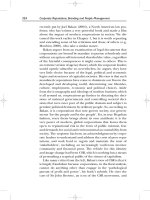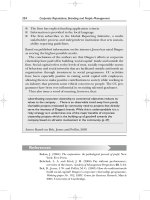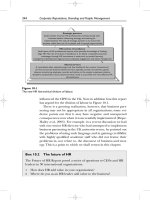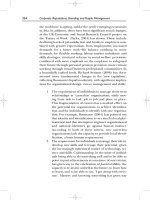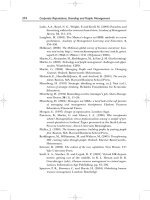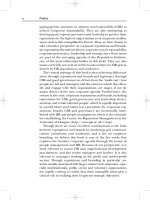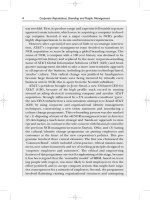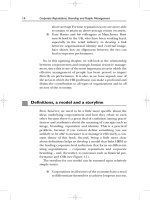Tài liệu Corporate Reputations, Branding and People Management 5 pdf
Bạn đang xem bản rút gọn của tài liệu. Xem và tải ngay bản đầy đủ của tài liệu tại đây (108.57 KB, 10 trang )
Identity
The interest of reputation management in organizational iden-
tity has its origins in earlier work by academics on individual
identity. Interest focused on how individuals came to take on
the identity of the groups and organizations with which they
interacted (the process of identification). Since then, this notion
of identity has metamorphosed into the idea of an organization
having an identity in its own right (an organizational identity),
either as a kind of collective supra-personality or, borrowing
from the legal concept of the firm, as a ‘social actor’ capable of
being held accountable and ‘finding one’s own place in soci-
ety’ (Whetten and Mackey, 2002).
In a classic interpretation of organizational identity, Albert
and Whetten (1985) outlined three of its central principles:
■ It should capture the essence or ‘claimed central char-
acter’ of the organization
■ It should set out its claimed distinctiveness
■ It should show continuity over time.
These principles are the usual starting point for more recent
discussions of the topic. Two of the most interesting concern its
continuity and central character. First, some writers claim that
fluidity and flexibility constitutes a requirement for organization
identities to cope with rapid environmental changes in the mod-
ern world (Goiia et al., 2000). Arguably, then, this third principle
should capture the idea of flexibility as well as endurance; what
Goiia et al. refer to as a ‘mutable identity’, capable of helping
an organization change over time. One good example these
researchers draw on is how IBM managed to change its view of
itself and its projected image as a single-minded mainframe
company in the 1980s in response to market changes so that
it could compete with small PC companies. Since then it has
undergone another identity change to a solutions-based com-
pany, but all the time retained elements of its original character.
Second, other writers point to the existence of multiple iden-
tities in organizations. This idea runs counter to the idea of
a monolithic corporateness but is probably a more realistic
picture of, and for, many organizations. For example, just as an
24 Corporate Reputations, Branding and People Management
individual can be a mother, doctor, athlete and daughter at the
same time, a hospital can be seen by its members as a business,
a caring organization and a professional organization. Thus,
how you see an organization at any point in time depends on
where you are viewing it from – from the perspective of a politi-
cian or financier looking for value for money, as a patient look-
ing for high levels of care, as a doctor looking for a place to
practise a craft and develop a reputation, or as a business jour-
nalist looking for a dramatic story (as in the case of Box 1.3). We
examine these issues more closely in Chapter 3 but they do sug-
gest that attempts by corporate communication departments
(in conjunction with a willing business press), to create corpor-
ate identities which are unrecognizable to employees, are coun-
terproductive in the long run; often they generate unofficial,
opposed identities and resentment towards heroic leadership.
Organization actions, governance and
leadership
Just as organizations can be said to have identities in their own
right they are often attributed with the ability to act. Whereas
organizational identity deals with the ‘Who are we?’ question
and how such conceptions influence the corporation’s autobi-
ography, its image cannot be sustained without supportive
organizational actions. Though the idea of organizations act-
ing (or making decisions, having an identity, learning, etc.) can
be considered as an anthropomorphism (attributing human
forms or qualities to entities that are not human), the idea is a
useful one in so far as it draws attention to the question: which
people are most influential in shaping organizational direction
and actions?
The usual answer, of course, is the board of directors, leaders
and senior managers. Good governance and leaders help bind
an organization together as it changes. They help organizations
to differentiate themselves from others and meet social legitim-
acy goals. Leaders’ actions symbolize the organizational iden-
tity. Finally, they also meet the needs of individuals and the
organization by taking on its collective work. One only needs to
Chapter 1 The importance of the corporate agenda and its links with HRM 25
look at cases of bad governance and leadership to see its impact
on organizations, and indeed, nation-states; witness the cases of
malpractice and unethical behaviour referred to earlier in the
well-documented cases of Enron and others (Clarke, 2004;
Kellerman, 2004). Particularly important to our framework, it is
through their actions or inactions that employees come to
understand and experience the ‘true’ identity of an organiza-
tion rather than that which is portrayed in mission statements
and public pronouncements (see Box 1.3). Governance and its
problems are embedded in the identity of organizations, or
more probably, their multiple identities.
In an enlightening participant observation study of a US vol-
untary organization, Golden-Biddle and Rao (1997) have shown
how its directors’ behaviours were embedded in the multiple
identities of the organization and helped create and sustain
them. These directors experienced not only role conflict result-
ing from competing expectations from their legal and fiduciary
obligations but ‘conflicts of commitment’ as they struggled to
reconcile incompatible expectations ensuing from their desire
to uphold two primary identities – ‘volunteer governance’, in
which the direction of the organization was invested in volun-
teers rather than professional managers, and to act as a ‘family of
friends’, which implied strong feelings of friendship among
directors and conflict avoidance at all costs. When faced with a
challenge to its ways of operating by a senior volunteer board
member who broke the rules of conflict avoidance, the organi-
zation’s identities were severely tested, but were effectively
repaired by breaching the contradictions between them through
an acceptable compromise. As this case demonstrates, gover-
nance and leadership action are embedded in the multiple orga-
nizational identities that helped create the problems of dual
commitment but also helped them work out a compromise solu-
tion that reinforced these identities. It also hints at how more
recent and well-documented problems of governance may have
arisen and been dealt with, in many cases unsatisfactorily, at least
from the perspective of the media and general public.
Leadership styles are also important in translating organiza-
tional identity into an image. We often refer to senior leaders’
(in)abilities to ‘walk the talk’ by acting out the mission and val-
ues statements, and to the gaps between ‘rhetoric and reality’ in
26 Corporate Reputations, Branding and People Management
which the leadership style is totally inconsistent with the usual
mantra of ‘people are our most important asset’. From an
employee perspective, there are few more important breeding
grounds for cynicism than the failure of senior leaders to match
organizational identity and image with action, as we have dis-
covered in a number of studies of organizational change (Pate
et al., 2000). The reverse is also true, however: employees are
known to invest their leaders with almost mythical qualities to
inspire them to achieve radical organizational transformations
(Martin and Riddell, 1996), though the higher the pedestal the
further the potential for a fall from grace. The major debate in
leadership most obviously related to this issue is the ubiquitous
division in nearly all studies on management between task-
oriented behaviours and person-oriented behaviours; like most
solutions in management, the idea of a compromise or ‘opti-
mization’ between them is the most favoured way forward.
Without attention to both performance and people, it is
unlikely the employees will identify with the organization and
act in ways that will enhance its image.
The individual employment
relationship, individual behaviours
and their links with organizational
identity
We contend there are processes at work in which individuals
may, under certain circumstances, come to incorporate elements
of their organization’s identity into their self-perceptions.
These processes draw on social identity and self-categorization
theories. One of our core messages for practitioners is as fol-
lows: changing employees’ identities is a more difficult and
uncertain task than most of basic culture management and
communications-driven, customer relationship texts would have
readers believe, notwithstanding the ethical problems and poten-
tial backlash from so-called ‘brandwashing’. Organizational iden-
tity (the ‘Who are we?’ question) and the relationships between
leadership and followers will depend on the ability of key
Chapter 1 The importance of the corporate agenda and its links with HRM 27
managers to understand and manage the psychological contracts
that exist in the organization, that is, the perceptions held by
individuals concerning organizational ‘promises’ and the rela-
tive values they place on these promises or expectations (Conway
and Briner, 2005). It will also depend on other key individual–
organizational linkages that contribute to the quality of indi-
vidual employment relations (see Chapter 4). These include:
individual identification (the ‘Who am I?’ question), internaliza-
tion (‘What do I believe in?’), psychological ownership (‘Do I feel
that the organization is mine?’) and commitment (‘Will I stay?’)
(Pierce et al., 2001; Sparrow and Cooper, 2003). Such a list is
often confusing for practitioners and is probably why the idea
of employee engagement has become so popular in recent years,
since it promises to tap into or overlay all of the others as a form
of temperature check for HR managers. However, like any
idea or tools claiming to do everything, it may end up doing
nothing particularly well; this, we believe, is the problem fac-
ing many of the consultancy-based engagement approaches.
Nevertheless, engagement does bring something extra that
organizational psychologists have sometimes failed to consider,
including, most importantly, measures of attitudes relevant to
business-related behaviours. These attitudinal dimensions of
business-related behaviours usually refer to a belief in the
organization and its mission; a desire to work to make things
better, an understanding of the business context and the strate-
gic drivers of the organization; respect for colleagues and will-
ingness to help them, willingness to go beyond contract, and
keeping up to date with developments in their field (Robinson
et al., 2004).
Recent academic research on engagement, and there has
been very little of that, has shown it to be positively related to
customer satisfaction (Harter et al., 2002), a lead indicator of
financial performance in tests of the service–profit chain in the
retailing and banking industries (Gelade and Young, 2005).
Though more work needs to be done on defining engagement
and its correlates, it shows promise as a concept.
Finally, it almost goes without saying, critical behaviours for
reputations and brands also depend on the outcomes of know-
ledge, skills and abilities – the human capital pool. Investment
in knowledge stocks and knowledge flows is one of the key
28 Corporate Reputations, Branding and People Management
